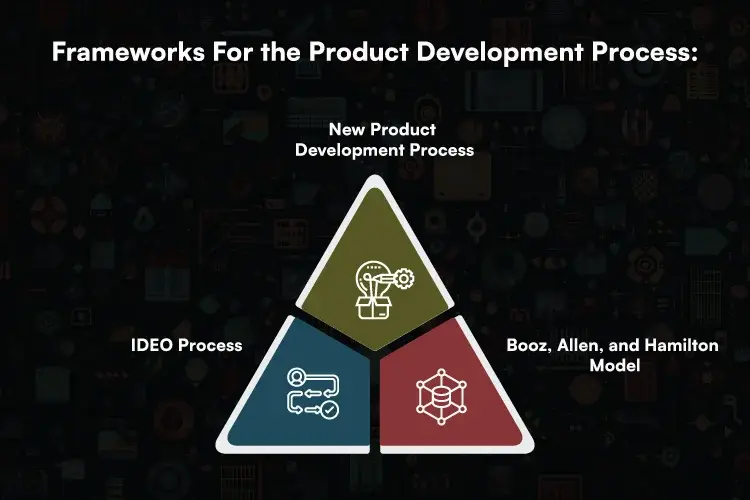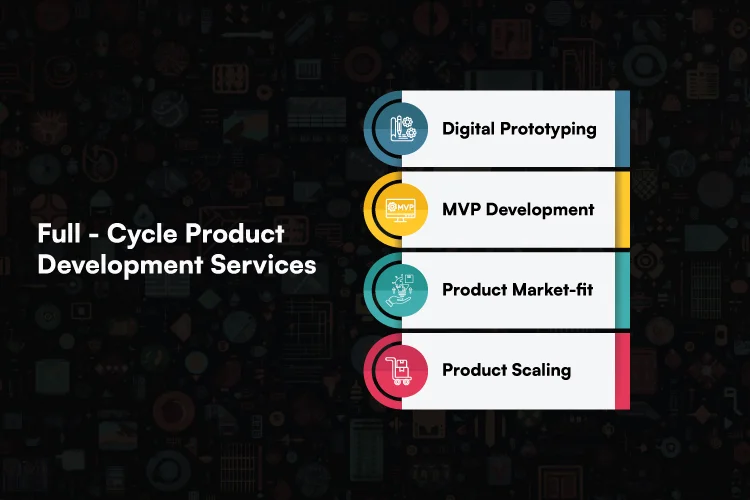What is a Product Development Life Cycle?
The product development life cycle describes how new ideas reach the market. From concept through commercialization, it walks prospective builders through the product development process in a way that minimizes risk while increasing the likelihood of success. It functions as a prelude to the introduction phase of the product life cycle.
The primary components of the product development cycle are market research, strategic planning, effective resource allocation, quality assurance and lastly iterative improvements.
Why is Full-Cycle Product Development Advantageous for Businesses?
To answer this question, businesses nowadays must meet the needs of their current customers on time to maintain their satisfaction. Leaders in any industry need a firm grasp of the whole product development lifecycle if they are to ensure the timely delivery of solutions.
Understanding the ins and outs of the system helps us estimate how long it will take to develop a product and understand the requirements in advance, which will help us to schedule releases so that everything gets done on time. One of the more challenging skills for leaders to learn is estimating project timelines effectively, given the many moving parts involved in creating a new product or improving an existing one. However, a major step in that direction would be taken if the complete product development cycle facts were known.
Full-Cycle Product Development Process:
- Ideation: It is the initial stage of any product development process. Ideation includes coming up with new concepts. The purpose here is to provide a list of problems that must be addressed.
- Validation: Validation determines concepts that are worth pursuing and the concepts which should be discarded. This step also determines whether there is a market for the potential items mentioned on your list, conduct online surveys, interviews, focus groups. Based on such prior findings, reduce your focus to a few promising concepts.
- Prototyping: Once an idea for a product has been decided, now it’s time to make a sample. Firstly, you have to figure out the most important features and tasks. These are the basic factors for your product when it comes to sales, and they should be based on the comments you got during the validation phase.
- Marketing: The next step after completing product prototyping, then start planning for your go-to-market strategy and determine possible competitors and try to create a unique value proposition for your product. Use these findings to develop a branding strategy and begin creating marketing materials.
- Development: Begin developing your MVP when your marketing initiatives come together. Remember that the solution does not have to be fully functional from the start. The goal is to introduce yourself to the market as soon as possible so that we can know about our actual customers. At the end, the finished prototype should contain enough details about your technical team to finally begin producing the device.
- Launch: It’s the last step for the product, make sure everything is in the correct place and functioning smoothly. However, this step focuses on finalizing integrations, setting up billing, and implementing user tracking and analytics. The launch should be exciting, but it’s just the starting point.
Frameworks for the Product Development Process:

There are many different frameworks that your company can use to build new goods quickly and effectively. There are mainly three different types of product development frameworks they are New Product Development (NPD) process, IDEO process, and Booz, Allen, and Hamilton (BAH) model.
The IDEO Approach:
IDEO is known as the world’s most innovative and an award-winning design framework, adopted by many consulting businesses. Its approach is customer-centric, and it believes that monitoring user’s behaviour is important, because it is key to know customer’s specific requirements.
The procedure is broken down into the following steps:
- Observe: Keep an eye on the market, on its demands, problems, and on the technological limits.
- Ideate: This step includes capture, synthesize, and filter client’s feedback and insights.
- Visualize: Visualize the new product being used by customers.
- Prototype: Create a rapid prototype of a product notion.
- Collect Feedback: Gather feedback from your intended audience.
- Implement: Based on the insights and feedback gained from the clients, refine and implement modifications in your product.
New Product Development (NPD) Process:
This is how most businesses that make physical products, usually in retail and online, do it. The process is not standard, and it depends on the organization’s structure, the industry, and how old the business is.
Steps for NPD Process are as Follows:
- Ideation of the Product: It’s the foremost step of the product development process. This step includes creating concepts for building a new product. Ideation is done with the whole development team and at the same time brainstorming potential ideas.
- Research on Product: When you have a final idea, now you must validate it according to your target audience needs. Connect with potential consumers and gather information about your target audience via surveys, support tickets, large-scale trends, and reports.
- Planning for the Product: Before you move on product prototyping, it is critical that you plan the product for the long term. However, in this step start thinking about the product design, contacting the manufacturers and suppliers, add price, etc.
- Prototyping of the Product: It is the process of creating a fully functional prototype that potential buyers can utilize.
- Sourcing of the Product: In this step identify and secure your key strategic partners, vendors, and suppliers you need to manufacture your product.
- Costing of the Product: Once your product is in production, you may anticipate future costs and improve procedures and materials to lower them.
The Booz, Allen, and Hamilton (BAH) Model:
The BAH model is one of the first models that businesses used to come up with new products, and companies still use it today. But most of the other models have been built on top of what BAH did.
The model is broken down into seven steps:
- Strategy for a New Product: Define and understand how the product fits in with the overall goals of the company.
- Idea Generation: Think of unique ways to develop the product.
- Screening and Judging: The goal of this step is to select the best ideas and then judge them.
- Business Analysis: Get a number-based assessment of the idea. For instance, Return on Investment (ROI), costs, and other forecasts.
- Development: The thought is turned into a product that can be used.
- Testing: This is when the product is put through tests in a business setting to see if it will work.
- Commercialization: It is when the product goes on sale to the public.
When Do You Need Full-Cycle Product Development?
Three points in a product’s life cycle when your clients approached you:
- The Onset of the Project
- Minimum Viable Product (MVP)
- Modernization Stage
The Onset of the Project:
The following ideation is an excellent starting point for delving into full-cycle product development. At this stage, you should have a finalized Project Scope, which is a document that reflects your product concept, technical requirements, features, and success metrics. When you contact a vendor of custom software product development services, they will have a better knowledge of your expectations, which is critical to the success of your collaboration.
The budget is another critical part of product development. A budget is a cost estimate that incorporates both direct and indirect costs associated with full-cycle product development, such as administrative, labor, and vendor expenditures.
Minimum Viable Product (MVP):
With a validated MVP, you can be sure that your idea isn’t built on quicksand. This makes it worth your while to spend on full-cycle product development. Many product development companies have ways to make sure that your early version grows into a full-fledged product that does well. In an ideal situation, the company should lay the groundwork for future product growth. So, a good reason to start full-cycle product development is to have a good MVP.
The Modernization Stage:
As technology progresses rapidly, it’s possible that your older programs won’t be able to keep up with what’s required now. Security holes, high maintenance costs, a lack of scalability, poor user experience (UX), and other problems may result from utilizing such software.
Product development service companies who focus on software upgrades can migrate your product to the cloud with minimal downtime.
Teams working on code refactoring will make the necessary and continue to function normally. Product development vendors often encounter the situation where they must add new features to proprietary software without disrupting the status of the product.
Finally, if you need to completely redesign your product, the experts at Cuneiform Consulting can help you design and implement brand-new features and update the underlying architecture to make it compatible with today’s technologies.
Cuneiform’s Full-Cycle Product Development Services:

- Digital Prototyping: A prototype is a digital simulation or demo of a product or service that lets you test assumptions and explore a product before it’s built. Prototyping is an important element of digital transformation for any firm because it lets you quickly learn more about your users, test assumptions, and get the information you need for building strong business cases for digital projects.
- MVP Development: In the context of testing business ideas, the MVP is seen as an experiment. It lets entrepreneurs test their theories to see if a business idea would work and make money. The goal of MVP is to start with a small use case, test it, and then decide if you need to change course and go in a different way or if you should keep working on the idea and turn it into a product solution.
- Product Market-Fit: Product Market-Fit is the term used for describing a product or service that meets the unmet needs of the target market in a way that keeps the market growing and makes money. The importance of this service is when you want your business to grow and your product to work well on a large scale.
- Product Scaling: Product scaling is all about ensuring that the product is strong enough to stand out in the market. Thus, the final goal is to make a product that works effectively, is safe, and can be used by a wider audience.
In conclusion, developing new products requires constant attention, investigation, and improvement. There are always new models, tools, and strategies to test out, and you need to learn what works best for you.
Remember, that preferences and requirements shift over time. Users’ knowledge about technology far exceeds that of their forebears. These days, they worry about their personal space, their morality, and their security. As a result,
Cuneiform Consulting Pvt. Ltd. keeps all these factors in mind and aims to deliver excellent services to produce successful outcomes and finally to stand out in accordance with the client’s expectations.




